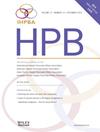Development of the liver resection transfusion (LiReT) score to assess the requirement for blood transfusion during open liver surgery
IF 2.4
3区 医学
Q2 GASTROENTEROLOGY & HEPATOLOGY
引用次数: 0
Abstract
Background
Liver resection involves significant perioperative bleeding and blood transfusions, which may worsen outcomes. Blood products are scarce, and excessive preoperative cross-matching can deplete the blood supply. This study aimed to develop a clinical prediction score to assess the need for perioperative blood transfusions during liver resection.
Methods
We conducted a retrospective cohort study using data from patients who underwent liver resections between 2006 and 2021. Independent predictors and a scoring system were analyzed using multivariable logistic regression. The model’s effectiveness was assessed by the area under the ROC curve (AuROC) and calibration plots, with internal validation.
Result
Among 1021 patients, 456 (44.7%) required perioperative blood transfusions. Eight predictors were identified: ASA classification >2, preoperative anemia, platelet count <100 × 109/L, albumin <3.5 g/dL, total bilirubin >1.2 mg/dL, GFR <60 ml/min/1.73 m², maximum tumor diameter ≥5 cm, and major liver resection. The LiReT score categorized patients into low, moderate, and high-risk groups and showed good discriminative ability with an AuROC of 0.808 and good calibration.
Conclusion
The LiReT score, with its good predictive accuracy, can guide clinicians in assessing perioperative blood transfusion risk, optimizing cross-matching and resource utilization, and facilitating patient blood management strategies during liver resection.
肝切除输血(LiReT)评分的发展,以评估开放肝手术中输血的需求。
背景:肝切除术围手术期出血和输血严重,可能使预后恶化。血液制品稀缺,术前过度交叉配型会耗尽血液供应。本研究旨在建立一个临床预测评分来评估肝切除术围手术期输血的需要。方法:我们进行了一项回顾性队列研究,使用了2006年至2021年间接受肝脏切除术的患者的数据。使用多变量逻辑回归分析独立预测因子和评分系统。通过ROC曲线下面积(AuROC)和标定图评估模型的有效性,并进行内部验证。结果:1021例患者中有456例(44.7%)需要围手术期输血。确定了ASA分级>2、术前贫血、血小板计数9/L、白蛋白1.2 mg/dL、GFR 8个预测指标。结论:LiReT评分具有较好的预测准确性,可指导临床医生评估围手术期输血风险,优化交叉配型和资源利用,为肝切除术患者血液管理策略提供依据。
本文章由计算机程序翻译,如有差异,请以英文原文为准。
求助全文
约1分钟内获得全文
求助全文
来源期刊

Hpb
GASTROENTEROLOGY & HEPATOLOGY-SURGERY
CiteScore
5.60
自引率
3.40%
发文量
244
审稿时长
57 days
期刊介绍:
HPB is an international forum for clinical, scientific and educational communication.
Twelve issues a year bring the reader leading articles, expert reviews, original articles, images, editorials, and reader correspondence encompassing all aspects of benign and malignant hepatobiliary disease and its management. HPB features relevant aspects of clinical and translational research and practice.
Specific areas of interest include HPB diseases encountered globally by clinical practitioners in this specialist field of gastrointestinal surgery. The journal addresses the challenges faced in the management of cancer involving the liver, biliary system and pancreas. While surgical oncology represents a large part of HPB practice, submission of manuscripts relating to liver and pancreas transplantation, the treatment of benign conditions such as acute and chronic pancreatitis, and those relating to hepatobiliary infection and inflammation are also welcomed. There will be a focus on developing a multidisciplinary approach to diagnosis and treatment with endoscopic and laparoscopic approaches, radiological interventions and surgical techniques being strongly represented. HPB welcomes submission of manuscripts in all these areas and in scientific focused research that has clear clinical relevance to HPB surgical practice.
HPB aims to help its readers - surgeons, physicians, radiologists and basic scientists - to develop their knowledge and practice. HPB will be of interest to specialists involved in the management of hepatobiliary and pancreatic disease however will also inform those working in related fields.
Abstracted and Indexed in:
MEDLINE®
EMBASE
PubMed
Science Citation Index Expanded
Academic Search (EBSCO)
HPB is owned by the International Hepato-Pancreato-Biliary Association (IHPBA) and is also the official Journal of the American Hepato-Pancreato-Biliary Association (AHPBA), the Asian-Pacific Hepato Pancreatic Biliary Association (A-PHPBA) and the European-African Hepato-Pancreatic Biliary Association (E-AHPBA).
 求助内容:
求助内容: 应助结果提醒方式:
应助结果提醒方式:


